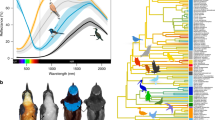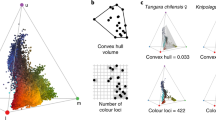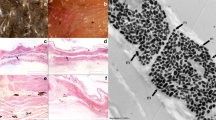Abstract
Animals living on the earth’s surface are protected from the damaging effects of solar ultraviolet (UV) radiation by melanin pigments that color their integument. UV levels that reach the earth’s surface vary spatially, but the role of UV exposure in shaping clinal variations in animal pigmentation has never been tested. Here, we show at a continental scale in Europe that golden eagles Aquila chrysaetos reared in territories with a high solar UV-B radiation exposure deposit lower amounts of the sulphurated form of melanin (pheomelanin) in feathers and consequently develop darker plumage phenotypes than eagles from territories with lower radiation exposure. This clinal variation in pigmentation is also explained by terrestrial γ radiation levels in the rearing territories by a similar effect on the pheomelanin content of feathers, unveiling natural radioactivity as a previously unsuspected factor shaping animal pigmentation. These findings show for the first time the potential of solar and terrestrial radiations to explain pigmentation phenotype diversity in animals, including humans, at large spatial scales.
Similar content being viewed by others
References
Alcaide M, Serrano D, Tella JL, Negro JJ (2009) Strong phylopatry derived from capture–recapture records does not lead to fine-scale genetic differentiation in lesser kestrels. J Anim Ecol 78:468–475
Beckmann M, Václavík T, Manceur AM, Šprtová L, Wehrden H, Welk E, Cord AF (2014) glUV: a global UV-B radiation data set for macroecological studies. Methods Ecol Evol 5:372–383
Bivand R, Keitt T, Rowlingson B (2017) rgdal: Bindings for the geospatial data abstraction library. R package version 1.2–8. Available at: http://www.gdal.org
Bräuner EV, Loft S, Sørensen M, Jensen A, Andersen CE, Ulbak K, Hertel O, Pedersen C, Tjønneland A, Kjær SK, Raaschou-Nielsen O (2015) Residential radon exposure and skin cancer incidence in a prospective Danish cohort. PLoS One 10:e0135642
Brenner M, Hearing VJ (2008) The protective role of melanin against UV damage in human skin. Photochem Photobiol 84:539–549
Burnham KP, Anderson DR (2002) Model selection and multimodel inference. A practical information-theoretic approach. Springer-Verlag, New York
Comont D, Martinez Abaigar J, Albert A, Aphalo P, Causton DR, Figueroa FL, Gaberscik A, Llorens L, Hauser M-T, Jansen MAK, Kardefelt M, de la Coba Luque P, Neubert S, Núñez-Olivera E, Olsen J, Robson M, Schreiner M, Sommaruga R, Strid Å, Torre S, Turunen M, Veljovic-Jovanovic S, Verdaguer D, Vidovic M, Wagner J, Winkler JB, Zipoli G, Gwynn-Jones D (2012) UV responses of Lolium perenne raised along a latitudinal gradient across Europe: a filtration study. Physiol Plant 145:604–618
Comont D, Winters A, Gomez LD, McQueen-Mason SJ, Gwynn-Jones D (2013) Latitudinal variation in ambient UV-B radiation is an important determinant of Lolium perenne forage production, quality, and digestibility. J Exp Bot 64:2193–2204
Core Team R (2017) R: a language and environment for statistical computing. R Foundation for Statistical Computing, Vienna
Crombie IK (1979) Variation of melanoma incidence with latitude in North America and Europe. Br J Cancer 40:774–781
D’Orazio JA, Nobuhisa T, Cui R, Arya M, Spry M, Wakamatsu K, Igras V, Kunisada T, Granter SR, Nishimura EK et al (2006) Topical drug rescue strategy and skin protection based on the role of Mc1r in UV-induced tanning. Nature 443:340–344
Dadachova E, Casadevall A (2008) Ionizing radiation: how fungi cope, adapt, and exploit with the help of melanin. Curr Opin Microbiol 11:525–531
Del Bino S, Ito S, Sok J, Nakanishi Y, Bastien P, Wakamatsu K, Bernerd F (2015) Chemical analysis of constitutive pigmentation of human epidermis reveals constant eumelanin to pheomelanin ratio. Pigment Cell Melanoma Res 28:707–717
Fargallo JA, Laaksonen T, Korpimäki E, Wakamatsu K (2007) A melanin-based trait reflects environmental growth conditions of nestling male Eurasian kestrels. Evol Ecol 21:157–171
Ferguson-Lees J, Christie DA (2001) Raptors of the world. Helm, London
Forster L, Forster P, Lutz-Bonengel S, Willkomm H, Brinkmann B (2002) Natural radioactivity and human mitochondrial DNA mutations. Proc Natl Acad Sci USA 99:13950–13954
Fransson T, Kolehmainen T, Kroon C, Jansson L, Wenninger T (2010) EURING list of longevity records for European birds. Available at: http://www.euring.org/data-and-codes/longevity-list?page=1
Galván I (2017) Condition-dependence of pheomelanin-based coloration in nuthatches Sitta europaea suggests a detoxifying function: implications for the evolution of juvenile plumage patterns. Sci Rep 7:9138
Galván I, Alonso-Alvarez C (2011) Natural radioactivity can explain clinal variation in the expression of melanin-based traits. Evol Ecol 25:1197–1203
Galván I, Jorge A (2015) Dispersive Raman spectroscopy allows the identification and quantification of melanin types. Ecol Evol 5:1425–1431
Galván I, Solano F (2016) Bird integumentary melanins: biosynthesis, forms, function and evolution. Int J Mol Sci 17:520
Galván I, Wakamatsu K (2016) Color measurement of the animal integument predicts the content of specific melanin forms. RSC Adv 6:79135–79142
Galván I, Bijlsma RG, Negro JJ, Jarén M, Garrido-Fernández J (2010) Environmental constraints for plumage melanization in the northern goshawk Accipiter gentilis. J Avian Biol 41:523–531
Galván I, Ghanem G, Møller AP (2012) Has removal of excess cysteine led to the evolution of pheomelanin? BioEssays 34:565–568
Galván I, Jorge A, Ito K, Tabuchi K, Solano F, Wakamatsu K (2013) Raman spectroscopy as a non-invasive technique for the quantification of melanins in feathers and hairs. Pigment Cell Melanoma Res 26:917–923
Galván I, Bonisoli-Alquati A, Jenkinson S, Ghanem G, Wakamatsu K, Mousseau TA, Møller AP (2014) Chronic exposure to low-dose radiation at Chernobyl favours adaptation to oxidative stress in birds. Funct Ecol 28:1387–1403
Galván I, Jorge A, García-Gil M (2017a) Pheomelanin molecular vibration is associated with mitochondrial ROS production in melanocytes and systemic oxidative stress and damage. Integr Biol 9:751–761
Galván I, Inácio Â, Romero-Haro AA, Alonso-Alvarez C (2017b) Adaptive downregulation of pheomelanin-related Slc7a11 gene expression by environmentally induced oxidative stress. Mol Ecol 26:849–858
Hansson LA, Hylander S, Sommaruga R (2007) Escape from UV threats in zooplankton: a cocktail of behavior and protective pigmentation. Ecology 88:1932–1939
Hijmans RJ, van Etten J (2016) raster: Geographic data analysis and modeling. R package version 2.5-8. Available at: http://cran.r-project.org/package=raster
Hofer R, Mokri C (2000) Photoprotection in tadpoles of the common frog, Rana temporaria. Photochem Photobiol 59:48–53
Hsiung BK, Blackledge TA, Shawkey MD (2015) Spiders do have melanin after all. J Exp Biol 218:3632–3635
Hsu SL, Moore WH, Krimm S (1976) Vibrational spectrum of the unordered polypeptide chain: a Raman study of feather keratin. Biopolymers 15:1513–1528
Hull JM, Anderson R, Bradbury M, Estep JA, Ernest HB (2008) Population structure and genetic diversity in Swainson’s Hawks (Buteo swainsoni): implications for conservation. Cons Gen 9:305
Ito S, Nakanishi Y, Valenzuela RK, Brilliant MH, Kolbe L, Wakamatsu K (2011) Usefulness of alkaline hydrogen peroxide oxidation to analyze eumelanin and pheomelanin in various tissue samples: application to chemical analysis of human hair melanins. Pigment Cell Melanoma Res 24:605–613
Jablonski NG, Chaplin G (2010) Human skin pigmentation as an adaptation to UV radiation. Proc Natl Acad Sci USA 107(Suppl. 2):8962–8968
Kim E, Panzella L, Micillo R, Bentley WE, Napolitano A, Payne GF (2015) Reverse engineering applied to red human hair pheomelanin reveals redox-buffering as a pro-oxidant mechanism. Sci Rep 5:18447
Lowe C, Goodman-Lowe G (1996) Suntanning in hammerhead sharks. Nature 383:677
Marionnet C, Pierrard C, Golebiewski C, Bernerd F (2014) Diversity of biological effects induced by longwave UVA rays (UVA1) in reconstructed skin. PLoS One 9:e105263
Megía-Palma R, Jorge A, Reguera S (2018) Raman spectroscopy reveals the presence of both eumelanin and pheomelanin in the skin of lacertids. J Herpetol 52(1):67–73
Mitra D, Luo X, Morgan A, Wang J, Hoang MP, Lo J, Guerrero CR, Lennerz JK, Mihm MC, Wargo JA et al (2012) An ultraviolet-radiation-independent pathway to melanoma carcinogenesis in the red hair/fair skin background. Nature 491:449–453
Møller AP, Mousseau TA (2013) The effects of natural variation in background radioactivity on humans, animals and other organisms. Biol Rev 88:226–254
Morgan AM, Lo J, Fisher DE (2013) How does pheomelanin synthesis contribute to melanomagenesis? BioEssays 35:672–676
Napolitano A, Panzella L, Monfrecola G, d’Ischia M (2014) Pheomelanin-induced oxidative stress: bright and dark chemistry bridging red hair phenotype and melanoma. Pigment Cell Melanoma Res 27:721–733
Neyfakh EA, Alimbekova AI, Ivanenko GF (1998) Radiation-induced lipoperoxidative stress in children coupled with deficit of essential antioxidants. Biochemistry (Moscow) 63:977–987
Nybakken L, Aubert S, Bilger W (2004) Epidermal UV-screening of arctic and alpine plants along a latitudinal gradient in Europe. Polar Biol 27:391–398
Panzella L, Leone L, Greco G, Vitiello G, D’errico G, Napolitano A, d’Ischia M (2014) Red human hair pheomelanin is a potent pro-oxidant mediating UV-independent contributory mechanisms of melanomagenesis. Pigment Cell Melanoma Res 27:244–252
Pavel S, Smit NPM, Pizinger K (2011) Dysplastic nevi as precursor melanoma lesions. In: Borovanský J, Riley PA (eds) Melanins and melanosomes: biosynthesis, biogenesis, physiological, and pathological functions. Wiley-Blackwell, Weinheim, pp 383–393
Peteya JA, Clarke JA, Li Q, Gao KQ, Shawkey MD (2017) The plumage and colouration of an enantiornithine bird from the Early Cretaceous of China. Palaeontology 60:55–71
Phillips RL, Cummings JL, Berry JD (1991) Responses of breeding golden eagles to relocation. Wildl Soc Bull 19:430–434
Pinheiro J, Bates D, DebRoy S, Sarkar D, R Core Team (2017) nlme: Linear and nonlinear mixed effects models. R package version 3.1-131. Available at: https://cran.r-project.org/package=nlme
Polidori C, Jorge A, Ornosa C (2017) Eumelanin and pheomelanin are predominant pigments in bumblebee (Apidae: Bombus) pubescence. PeerJ 5:e3300
Poston JP, Hasselquist D, Stewart IRK, Westneat DF (2005) Dietary amino acids influence plumage traits and immune responses of male house sparrows, Passer domesticus, but not as expected. Anim Behav 70:1171–1181
Riley PA (1994) Free radicals in biology: oxidative stress and the effects of ionizing radiation. Int J Radiat Biol 65:27–33
Sarkar AK (2004) An evaluation of UV protection imparted by cotton fabrics dyed with natural colorants. BMC Dermatol 4:15
Schreiber RW, Schreiber EA, Peele AM, Burtt EH Jr (2006) Pattern of damage to albino Great Frigatebird flight feathers supports hypothesis of abrasion by airborne particles. Condor 108:736–741
Seckmeyer G, Pissulla D, Glandorf M, Henriques D, Johnsen B, Webb A, Siani A-M, Bais A, Kjeldstad B, Brogniez C, Lenoble J, Gardiner B, Kirsch P, Koskela T, Kaurola J, Uhlmann B, Slaper H, den Outer P, Janouch M, Werle P, Gröbner J, Mayer B, de la Casiniere A, Simic S, Carvalho F (2008) Variability of UV irradiance in Europe. Photochem Photobiol 84:172–179
Spycher BD, Lupatsch JE, Zwahlen M, Röösli M, Niggli F, Grotzer MA, Rischewski J, Egger M, Kuehni CE, for the Swiss Pediatric Oncology Group and the Swiss National Cohort (2015) Background ionizing radiation and the risk of childhood cancer: a census-based nationwide cohort study. Environ Health Perspect 123:622–628
Swann HK (1924) On the races of the golden eagle (Aquila chrysaëtos). Bull Br Orn Club 45:64–73
Szegvary T, Conen F, Stöhlker U, Dubois G, Bossew P, de Vries G (2007) Mapping terrestrial & γ-dose rate in Europe based on routine monitoring data. Radiat Meas 42:1561–1572
Takaki Y, Kawahara T, Kitamura H, Endo K-I, Kudo T (2009) Genetic diversity and genetic structure of northern goshawk Accipiter gentilis populations in eastern Japan and central Asia. Cons Genet 10(269):279
Tao Z, Zha Y, Akiba S, Sun Q, Zou J, Li J, Liu Y, Kato H, Sugahara T, Wei L (2000) Cancer mortality in the high background radiation areas of Yangjiang, China during the period between 1979 and 1995. J Rad Res 41(Suppl):S31–S41
Vernet M, Diaz SB, Fuenzalida HA, Camilion C, Booth CR, Cabrera S, Casiccia C, Deferrari G, Lovengreen C, Paladini A, Pedroni J, Rosales A, Zagarese H (2009) Quality of UVR exposure for different biological systems along a latitudinal gradient. Photochem Photobiol Sci 8:1329–1345
Wang C, Han XS, Li FF, Huang S, Qin YW, Zhao XX, Jing Q (2016a) Forkhead containing transcription factor Albino controls tetrapyrrole-based body pigmentation in planarian. Cell Disc 2:16029
Wang H, Osseiran S, Igras V, Nichols AJ, Roider EM, Pruessner J, Tsao H, Fisher DE, Evans CL (2016b) In vivo coherent Raman imaging of the melanomagenesis-associated pigment pheomelanin. Sci Rep 6:37986
Acknowledgements
IG is supported by a Ramón y Cajal Fellowship (RYC-2012-10237) from the Spanish Ministry of Economy and Competitiveness (MINECO). We thank Jānis Ķuze, Carl Knoff, Peter L. Pap and Gabriel Banderet for field work in Latvia, Norway, Romania and Switzerland, respectively. Metod Macek and Anton Sedlak helped with field work in Slovakia. Ulf Johansson provided us with samples from the Swedish Museum of Natural History. Rafael Márquez helped with the spectrophotometric analyses of feathers. T. Szegvary kindly allowed us to use their map of terrestrial γ-dose rates for Europe. Four reviewers commented on the manuscript.
Author information
Authors and Affiliations
Contributions
IG conceived the study, contributed to sampling, analyzed the data and wrote the manuscript. AJ conducted the analyses of Raman spectroscopy. CP, DS, DJH, CI, JK, JTN, TO, GS and MS contributed to sampling. JJN contributed to sampling and manuscript writing.
Corresponding author
Ethics declarations
Conflict of interest
The authors declare that they have no conflict of interest.
Statement of animal rights
All applicable institutional and/or national guidelines for the care and use of animals were followed.
Additional information
Communicated by Indrikis Krams.
Electronic supplementary material
Below is the link to the electronic supplementary material.
Rights and permissions
About this article
Cite this article
Galván, I., Jorge, A., Pacheco, C. et al. Solar and terrestrial radiations explain continental-scale variation in bird pigmentation. Oecologia 188, 683–693 (2018). https://doi.org/10.1007/s00442-018-4238-8
Received:
Accepted:
Published:
Issue Date:
DOI: https://doi.org/10.1007/s00442-018-4238-8









